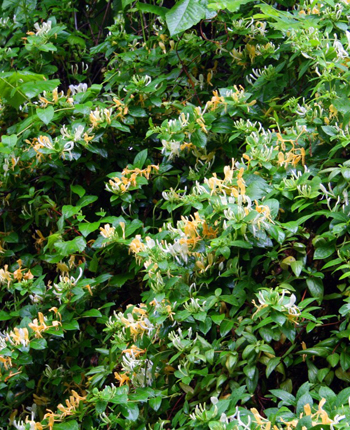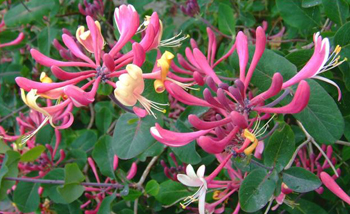Contents:
Common Names | Parts Usually Used | Plant(s) & Culture | Where Found | Medicinal Properties | Biochemical Information
Legends, Myths and Stories | Uses | Formulas or Dosages | Warning | Bibliography
Scientific Names

- Lonicera periclymenum L.
- Lonicera Japonica
- Caprifoliaceae
- Honeysuckle family
Common Names
Lonicera periclymenum:
- European honeysuckle
- Woodbine
Lonicera Japonica:
- Chinese honeysuckle
- Japanese honeysuckle
- Jin yin hua
- Ren dong teng
Parts Usually Used
Lonicera periclymenum:
Flowers, bark
Lonicera Japonica:
Bark, flowers, leaves
Back to Top

Description of Plant(s) and Culture
Lonicera periclymenum:
“Who does not know the honeysuckle?” No need to describe it.
The flowers of this plant, pink, creamy-yellow and purple, are not only pretty but are medicinal as well. They are sweet-tasting and may be eaten raw.
Lonicera Japonica:
Japanese honeysuckle is an evergreen trailing, twining vine. The leaves are oval, entire (not toothed) and the flowers are white or buff; lobes are strongly spreading from the throat, stamens protruding; flowers in April and July.
This evergreen trailing twining vine has become a troublesome weed in the South. The flowers are white but quickly fade to yellow, earning the plant the name “Gold and Silver Flower” in China. The leaves and flowers are used in Traditional Chinese Medicine.
Another variety: Called honeysuckle (L. interrupta). The leaves were used by Yuki (California) to wash sores (SEE SORES). Shoshones pound raw root and apply to swellings.
Back to Top
Where Found
Lonicera periclymenum:
The borders of woods, in hedges.
Lonicera Japonica:
Noxious weed in much of the southern states; north to Massachusetts, Indiana.
Back to Top

Medicinal Properties
Lonicera periclymenum:
Diuretic, antispasmodic, expectorant, laxative, emetic
Lonicera Japonica:
Alterative, antiviral, antibacterial, antibiotic, antispasmodic, astringent, diuretic, diaphoretic, febrifuge, refrigerant
Back to Top
Biochemical Information
Lonicera periclymenum:
Tannin, flavonoids, mucilage, sugars, salicylic acid
Lonicera Japonica:
Luteolin, inositol, tannin, sugars, mucilage
Back to Top
Legends, Myths and Stories
Lonicera periclymenum:
Pliney recommended woodbine to be taken in wine for spleen disorders.
Lonicera Japonica:
Today, Chinese honeysuckle is more likely to be used medicinally. This was first listed in the Tang Ben Cao, written in 659 AD and is one of the most important Chinese herbs for clearing poisons from the body.
Yuki Basketry: On the Round Valley Reservation, the original inhabitants were Yukis. Materials were much the same as those used by their neighbors, except that in addition to those, Yukis used maple and honeysuckle to make baskets.
Another plant called honeysuckle is Diervilla canadensis.
Back to Top
Uses
Lonicera periclymenum:
A tonic for the heart and a remedy for most cardiac disorders. It is good for chest colds, coughs, and asthma, rheumatism, arthritis, swollen glands including mumps, childbirth, liver trouble, sore throat, dropsy, and ailments of the skin.
Lonicera Japonica:
Honeysuckle is used for infections and inflammations and has broad spectrum antimicrobial activity against Salmonella typhi, Pseudomonas aeruginosa, Staphylococcus aureus and Streptococcus pneumoniae. Leaves and flowers make a beverage tea in Japan. Flowers traditionally used in eastern Asia in tea for bacterial dysentery, enteritis, laryngitis, conjunctivitis, inflammations of the urinary tract and reproductive organs, fevers, colds, flu. Often combined with forsythia fruit. It is similar to the echinacea of Chinese medicine. Externally, as a wash for rheumatism, sores, tumors (especially breast cancer), infected boils, scabies, swelling. The stem tea is weaker. Experimentally, flower extracts lower cholesterol; reduces blood pressure, also used to treat tuberculosis. This serious weed might be managed by utilizing it for proven medical purposes.
Recent studies in China have found honeysuckle to be effective in treatment of certain cancers, especially of the breast.
This is the same plant as the commonly known ornamental flower.
Back to Top
Formulas or Dosages
Lonicera periclymenum:
Harvest in summer.
Syrup: infuse 4 lb. of fresh petals and 1 quart boiling water in a covered vessel for 12 hours; express lightly at the end of that time, then decant. Add twice the weight of white sugar and make a syrup. Take a dessert-spoonful daily.
Infusion: for those who would prefer something less sickly, and less fattening, than the syrup, can prepare a standard infusion or decoction from the grated bark; 1 part bark to 7 parts water. Take 2 cupfuls daily.
Lonicera Japonica:
Harvest in summer.
May use the same instructions for syrup and infusion.
Back to Top
Warning
Lonicera (various species) have somewhat poisonous fruits and also emetic.
Back to Top
Bibliography
![]() American Folk Medicine
American Folk Medicine, by Clarence Meyer, Meyerbooks, publisher, PO Box 427, Glenwood, Illinois 60425, 1973
![]() The Complete Medicinal Herbal
The Complete Medicinal Herbal, by Penelope Ody, Dorling Kindersley, Inc, 232 Madison Avenue, New York, NY 10016, First American Edition, copyright 1993
![]() Eastern/Central Medicinal Plants
Eastern/Central Medicinal Plants, by Steven Foster and James A. Duke., Houghton Mifflin Company, 215 Park Avenue South, New York, NY 10000
 How Indians Use Wild Plants for Food, Medicine & Crafts
How Indians Use Wild Plants for Food, Medicine & Crafts, by Frances Densmore, Dover Publications, Inc., 180 Varick Street, New York, NY 10014, first printed by the United States Government Printing Office, Washington, in 1928, this Dover edition 1974
![]() Indian Uses of Native Plants
Indian Uses of Native Plants, by Edith Van Allen Murphey, Meyerbooks, publisher, PO Box 427, Glenwood, Illinois 60425, copyright 1958, print 1990
 The Magic of Herbs
The Magic of Herbs, by David Conway, published by Jonathan Cape, Thirty Bedford Square, London, England. (Out of print)
![]() Planetary Herbology
Planetary Herbology, by Michael Tierra, C.A., N.D., O.M.D., Lotus Press, PO Box 325, Twin Lakes. WI 53181., Copyright 1988, published 1992
![]() Webster’s New World Dictionary
Webster’s New World Dictionary, Third College Edition, Victoria Neufeldt, Editor in Chief, New World Dictionaries: A Division of Simon & Schuster, Inc., 15 Columbus Circle, New York, NY 10023
 The Rodale Herb Book: How to Use, Grow, and Buy Nature’s Miracle Plants (An Organic gardening and farming book)
The Rodale Herb Book: How to Use, Grow, and Buy Nature’s Miracle Plants (An Organic gardening and farming book), edited by William H. Hylton, Rodale Press, Inc. Emmaus, PA, 18049., 1974
